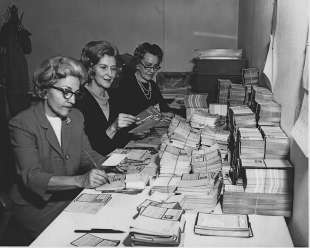Seattle Opera Guild

Guild Volunteers Mrs. P. P. Mairorano, Mrs. Roy F. Boese, Mrs. Peyton Autry at work processing ticket orders in the first few years of Seattle Opera. © Seattle Times
In the mid-1950s, comparatively few women worked outside the home. Arts, educational, and philanthropic causes had a large volunteer force of wives and mothers who had free hours among their other responsibilities when the kids were in school. This volunteer force proved of immense aid to arts organizations that relied on women to raise money, sell tickets, help with the visiting artists, provide food and hospitality, and sometimes create props and décor for productions.
Following the bankruptcy of Northwest Grand Opera in 1957, Helen Jensen urged her fellow Guild members to stick with it: “For the cause of great art, I felt very strongly that the Guild should continue to keep interest alive in the region, especially since the World’s Fair called for an Opera House.”
So the Guild pressed forward and expanded. To the original two study groups (as the branches were originally called) were added three more in 1958. By 1958-59, the roster stood at 149 members, all engaged in raising awareness of opera and also raising money for the 1962 World’s Fair production of Aida. The Guild groups presented a three-day opera film festival each spring, and co-sponsored the annual Metropolitan Opera National Council’s Northwest Regional Auditions, with a committee assisting with the presentation and a cash award to winners. A locally based scholarship program to promote the careers of young Northwest singers was inaugurated. From the proceeds of the first all-Guild fundraising project (a film showing of Il barbiere di Siviglia at Seattle’s Varsity Theatre in May of 1959), $500 was raised and then presented to baritone Roald Reitan of Tacoma, winner of the 1959 Met Regionals, to assist in his studies in New York.
The Guild groups continued to expand as Western Opera merged with the opera committee of Seattle Symphony, and Seattle Opera was born. By 1966, the Guild’s membership numbered 702. The Guild purchased 1,000 Seattle Opera tickets for students; youth opera programs brought students in to the Seattle Center Playhouse (now the Intiman Theatre) for performances of Hansel and Gretel, and took a touring production of The Abduction from the Seraglio to Hoquiam, Centralia, Bellingham, and Everett. Cash awards were given to winners of the Metropolitan Opera and San Francisco Opera auditions and to University of Washington students; Guild groups (now there were an even dozen of them) sold opera recordings, booklets about plantings on Seattle Center grounds, and “beautiful Italian-made wine cruets.”
Today there are 11 groups, operating more or less independently to organize opera previews, special events, and fundraising. Adapting over the decades to social and economic change, the Guild has survived because of the enduring desire of the community’s opera lovers to get together with like-minded devotees in delightful settings, as they work hard to promote this expensive art form. It’s a formula that continues to work, after nearly six decades of tooting opera’s horn.